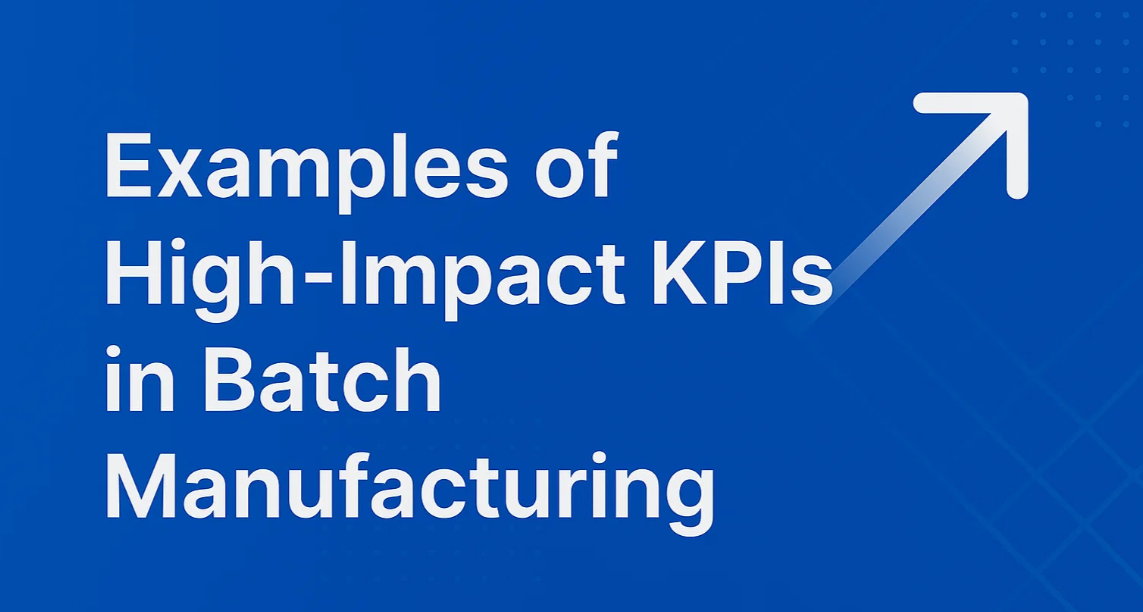Key Takeaways:
-
-
-
KPIs are strategic tools that guide long-term improvement and align with business objectives, not just day-to-day metrics.
-
Top manufacturers track fewer, more focused KPIs to drive clarity, reduce noise, and maintain accountability.
-
Every KPI should have an owner to ensure responsibility and follow-through across departments.
-
A balanced mix of leading and lagging indicators helps teams manage both current performance and future risks.
-
KPIs should spark action-oriented conversations rather than serve as static data points.
-
Industry-specific KPIs deliver the most value when tailored to each plant’s unique goals and regulatory needs.
-
KPI programs succeed when embedded in culture because they drive behavior, decision-making, and continuous improvement.
-
-
In batch manufacturing, where consistency, compliance, and cost control are mission-critical, organizations depend on data to drive decisions. But not all data contributes to improvement.
Across sectors such as pharmaceuticals, food and beverage, specialty chemicals, and cosmetics, manufacturing leaders often find themselves surrounded by performance reports, dashboards, and ERP-generated metrics. Yet despite the availability of this information, meaningful change can remain elusive.
Why? Because data volume does not guarantee operational clarity.
The difference lies in how Key Performance Indicators (KPIs) are selected, implemented, and utilized. When applied with purpose, KPIs help manufacturers transition from reactive firefighting to proactive, continuous improvement.

Understanding the Strategic Distinction Between KPIs and PIs
Manufacturers routinely track numerous process and performance metrics. These include machine uptime, operator hours, inventory usage, and more. While this data provides insight into plant activity, it is essential to distinguish between two critical measurement categories:
- Performance Indicators (PIs): Tactical metrics used to manage daily operations. Examples include equipment downtime during a shift or weight accuracy during ingredient dispensing.
- Key Performance Indicators (KPIs): Strategic metrics tied to organizational objectives. These guide long-term decisions and serve as leading indicators of business health.
Where PIs help monitor real-time execution, KPIs enable cross-functional alignment, performance benchmarking, and continuous improvement at scale.
Why Manufacturers Love the Idea of KPIs
People in manufacturing are problem solvers. They believe in logic, process, and continuous improvement. The idea that you can measure your way to better performance is not just appealing, it’s deeply woven into the culture.
And in theory, it’s true.
If you can’t measure it, you can’t improve it, right?
The problem is, the way most companies go about measurement is wrong. They believe the lie that:
“If we track more metrics, we’ll find more insights.”
But what actually happens is this:
- Metrics multiply.
- Focus scatters.
- Accountability fades.
- No one knows which number really matters.
That’s when teams start faking the charts. Not because they’re dishonest, but because they’re overwhelmed. The system asked them to watch 27 KPIs, and they’re just trying to make it to shift change.

Aligning KPIs with Business Objectives
Effective KPIs are derived from a clear understanding of strategic priorities, and the ultimate strategic priority for any organization is money. If your KPIs are not tied back to a healthier bottom line, then they are not effective KPIs. For most batch manufacturers, these typically fall into five categories:
- Efficiency – Reduce downtime, optimize batch cycle times, increase throughput.
- Quality – Minimize deviations, improve “Right First Time” rates, ensure GMP compliance.
- Cost Control – Lower waste, manage raw material yield, reduce energy usage.
- Compliance – Track training completion, CAPA closure rates, and audit readiness.
- Supply Chain Reliability – Ensure timely delivery of inputs and accuracy in inventory.
The most successful plants avoid adopting generic KPI templates. Instead, they work backward from their operational goals to identify metrics that provide meaningful feedback.
For example, a cosmetics manufacturer introducing new SKUs may prioritize batch yield and changeover time, while a pharmaceutical plant preparing for a regulatory inspection might emphasize CAPA implementation time and audit observation closure.
What Successful Manufacturers Do Differently
The best plants in the world don’t track more metrics. They track fewer, and better, ones.
They understand that KPIs are not just numbers. They are narratives. Every KPI tells a story about what the company values, where the risk is, and who’s responsible for fixing it.
Here’s what they do:
- They Start with a Strategic Narrative
They don’t say, “We want better numbers.” They say, “We want to reduce batch loss by 30% this year.” Then they ask, “What do we need to see every week to know we’re on track?”
That question generates aligned, powerful KPIs, like:
- Yield per batch
- Deviation rate
- RFT (Right First Time)
- Material usage variance
Every metric is linked to a business priority. And every person knows how their actions move the needle.
- They Assign Ownership
In high-performance operations, every KPI has a name next to it.
That’s not micromanagement, it’s clarity. When “CAPA Closure Time” belongs to QA, and “Downtime per Line” belongs to Ops, people don’t just track, they improve.
- They Balance Leading and Lagging KPIs
Bad plants chase the past. Good plants manage the future.
- Lagging KPI: Yield, scrap rate, cost per batch.
- Leading KPI: % of planned maintenance completed, % of materials meeting spec on delivery.
Successful Manufacturing plants use both. They track results and the behaviors that drive them.
- They Use KPIs to Drive Conversations, Not Reports
If your KPI meeting is just a data download, you’ve already lost. Top-tier manufacturers use KPIs as discussion starters:
- “Why is RFT down this month?”
- “What changed in our compounding process?”
- “Are we seeing more variability in raw inputs?”
KPIs become clues, not conclusions.

Examples of High-Impact KPIs in Batch Manufacturing
Production Performance
-
Overall Equipment Effectiveness (OEE)
Consolidates availability, performance, and quality into a single efficiency metric.
-
Cycle Time per Batch
Measures processing time and highlights potential bottlenecks.
-
Yield Percentage
Indicates the proportion of finished product relative to raw material input.
Quality Assurance
-
Right First Time (RFT)
Reflects the percentage of batches meeting all quality and regulatory specifications without rework.
-
Deviation Rate
Tracks frequency of non-conformance incidents, critical for GMP environments.
-
CAPA Closure Time
Assesses responsiveness to process deviations or audit findings.
Inventory and Supply Chain
-
Inventory Turnover
Measures the frequency with which inventory is consumed and replenished.
-
Raw Material Wastage Rate
Identifies inefficiencies in handling and storage practices.
-
Supplier On-Time Delivery Rate
Evaluates reliability of critical material inputs.
Cost and Energy Efficiency
-
Cost per Batch
Includes material, labor, and overhead costs, allowing for granular profitability analysis.
-
Scrap Rate
Reflects loss due to non-reworkable material or packaging defects.
- Energy Consumption per Unit ProducedSupports sustainability initiatives and cost savings.

How to Make KPIs Operationally Effective
The true value of KPIs emerges when they are used to inform decisions, not simply populate reports. Leading manufacturers implement the following practices to ensure KPIs translate into meaningful improvement:
- Establish Ownership and Accountability
Each KPI must have a designated owner, typically a team lead, department manager, or quality supervisor. Ownership drives responsibility, fosters initiative, and ensures that trends are not ignored.
- Standardize Review Cadence and Context
KPI review meetings should occur at regular intervals and focus on both trend analysis and underlying causes. For example, a drop in OEE may trigger a structured review of maintenance logs, shift handovers, and changeover procedures.
- Prioritize a Balanced Set of Leading and Lagging Indicators
Lagging KPIs reflect outcomes (e.g., cost per batch), while leading KPIs forecast future performance (e.g., preventive maintenance completion). A balanced mix ensures short-term visibility and long-term predictability.
- Integrate KPIs Into Daily Management Systems
Visual dashboards, Gemba boards, and ERP-linked scorecards can support real-time monitoring. The key is to ensure that data is accessible, interpretable, and tied to front-line decision-making.
Overcoming Common Pitfalls in KPI Implementation
Even with the best intentions, KPI programs can stall. Here are the most frequent challenges, and how to resolve them:
- Over-measurement: Attempting to track too many KPIs dilutes focus. The solution is to concentrate on 5–7 core metrics per department, linked to business-critical outcomes.
- Lack of alignment: Metrics that do not support strategic goals or that conflict across departments lead to misdirection. Cross-functional planning is essential.
- Passive reporting: KPIs that are reviewed but not acted upon erode credibility. Ensure that every KPI has a threshold, an owner, and an associated action plan.
- Short-termism: Focusing only on immediate results can undermine longer-term capability building. Leading KPIs and periodic strategy reviews help maintain balance.

Industry-Specific KPI Examples
To make KPI frameworks relevant and actionable, they must reflect the unique demands of different batch manufacturing sectors. Below is a breakdown of high-impact KPIs, tailored by industry.
Pharmaceutical Manufacturing
In pharmaceutical environments, precision and compliance dominate KPI planning. Regulatory readiness and product quality are non-negotiable.
- Right First Time (RFT): A critical quality metric indicating batch approval without rework.
- Deviation Rate: Tracks GMP failures and process inconsistencies.
- CAPA Implementation Time: Reflects how efficiently quality issues are addressed.
- Batch Release Cycle Time: Influences product availability and customer delivery timelines.
- Audit Readiness Score: A composite of completed internal checks and outstanding compliance issues.
Food and Beverage Processing
Food and beverage manufacturers must balance high throughput with traceability and freshness. Speed and safety go hand-in-hand.
- OEE (Overall Equipment Effectiveness): Assesses plant efficiency and readiness.
- Yield Loss Percentage: Measures material loss between input and output.
- Batch Cycle Time: Affects responsiveness to seasonal and order-based demand.
- Clean-in-Place (CIP) Compliance Rate: Ensures hygienic processing environments.
- Order Fill Rate: Customer satisfaction indicator tied to fulfillment performance.
Cosmetics and Personal Care
Cosmetics manufacturers manage complex formulations and small-batch variability. Branding depends on consistency and rapid product rollout.
- Batch-to-Batch Variability: Tracks color, texture, and viscosity tolerances.
- Raw Material Rejection Rate: Reflects upstream quality and procurement effectiveness.
- Changeover Time: Impacts agility in switching between product lines.
- Customer Complaint Rate: Monitors product issues from the market.
- Time-to-Market for New SKUs: Links innovation to production readiness.
Specialty Chemicals
Specialty chemical operations prioritize safety, precision blending, and environmental controls. Operational risk is high, and so is product complexity.
- Process Safety Incident Rate: Measures hazardous event frequency.
- Formula Adherence Compliance: Confirms batch input accuracy.
- Energy Consumption per Batch: Tracks cost and sustainability metrics.
- Inventory Accuracy: Ensures correct raw material handling.
- Delivery-In-Full On-Time (DIFOT): Balances logistics with customer expectations.
Embedding KPIs into the Culture of Improvement
Key Performance Indicators are not merely measurement tools; they are enablers of operational transformation. When chosen thoughtfully and aligned with strategy, KPIs become a shared language across functions, clarifying expectations and motivating action.
The organizations that excel at continuous improvement use KPIs not just to report results, but to anticipate risk, guide investment, and drive accountability. Their success is not rooted in how many metrics they track, but in how well those metrics reflect what truly matters.
For batch manufacturers aiming to elevate performance, the next step is not to gather more data, but to ask better questions, and use KPIs to find the answers that lead to lasting change.
Indicators that compliance is not sufficiently integrated into your financial systems include:
- Reliance on manual methods to track lot numbers, ingredients, or production records.
- Extended response times during mock audits or supplier verifications.
- Inability to tie financial data to batch traceability information in a seamless manner.
Frequently Asked Questions
About the Author
Peter Suddard has extensive experience working with batch process manufacturers, assisting them in scaling and enhancing their operations. His expertise lies in ensuring customer success and driving product improvements, making him a valuable resource for manufacturers aiming to grow. Peter also co-hosts the Better Batch Podcast, where he shares insights on optimizing batch manufacturing processes.

